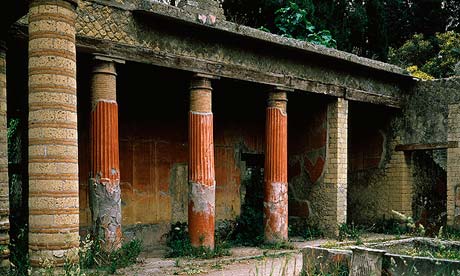 |
With several dozen rooms, the House of the
Telephus Relief was 'top-level Roman real
estate'. Photograph: Art Archive/Alamy
|
For almost two millennia, the piles of wood lay undisturbed and largely intact under layers of hardened volcanic material.
Now, after three years of painstaking work, archaeologists at Herculaneum have not only excavated and preserved the pieces, but worked out how they fitted together, achieving the first-ever full reconstruction of the timberwork of a Roman roof.
Archaeologists are to dig at a Bronze Age site near Peterborough for the first time in 10 years. They are hoping to find clues about an ancient timber structure at Flag Fen. In previous digs they found the UK's oldest wheel and gold rings more than 3,500 years old.
Israeli archaeologists have recently unearthed a palace at the Tel Hatzor National Park in Upper Galilee, revealing rare findings – jugs containing scorched wheat from some 3,400 years ago.
A team of U.S. and Iranian archaeologists have recently commenced a series of underwater excavations to identify the ruins of the historical port of Siraf in the Persian Gulf. With a about an 1100-year-old history, Siraf is located in the northwestern part of Bushehr Province in southern Iran.
Prof Higham (72) has been awarded the Grahame Clark medal for 2012 by the British Academy. Awarded for the first time in 1993, it is handed out every two years by the national academy for the humanities and social sciences.
Archaeologists are finding ancient remains that might be of Native Americans beneath the reconstruction of Highway 35. Scientists from the Mississippi Valley Archaeology Center have found almost two dozen likely skeletal fragments. They've also found hundreds of food and garbage pits, cooking hearths, tools and other artifacts of the Oneota people who inhabited the Onalaska area between about 1300 and 1600 A.D.







0 Comments:
Post a Comment
We appreciate comments, but we delete SPAM.